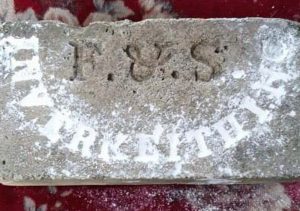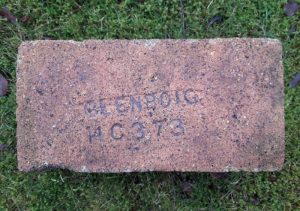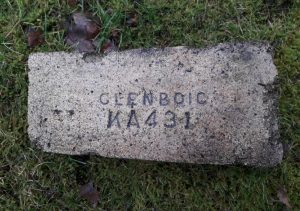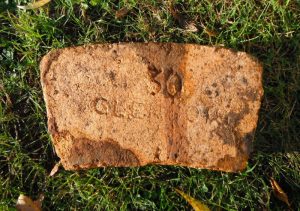Garnqueen Fireclay Works, Glenboig, Lanarkshire.
Gartliston Fireclay Works, Glenboig, Lanarkshire.
Gartliston (opened 1889) and Garnqueen (opened 1895) which was closer to Glenboig village, being about 1 mile south-east of the village.
Canmore – Gartliston.
Canmore – Garnqueen.
P & M Hurll Ltd owned Birkhill Clay Mine in Bo’ness. Birkhill Clay Mine had high-quality fireclay deposits which have been exploited since the 18th century. The partnership of P & M Hurll Ltd, Glenboig, was established around 1887. Mark Hurll, a firebrick manufacturer from Glenboig, Lanarkshire, leased Birkhill from Hamilton Estates in 1908 and the company took over the mine in 1916. P & M Hurll went into liquidation in July 1980.
Mark Hurll, jun. (of Peter & Mark Hurll, Ltd.) Ho., 1109 Aikenhead road, S.4. Hurll, Peter & Mark, Ltd., manufacturers of firebricks, furnace blocks, gas retorts and fittings, Gartliston and Garnqueen Works, Glenboig. Also building Bricks at Garscadden Works, Drumchapel; office, 144 W. Regent St. C.2; depot, St, Rollox; Tel. No., 147 Douglas; telegrams, ” Hurll, Glasgow.” Hurll, Thomas R. C. (Peter & Mark Hurll, Ltd.); Ho., Braeriach, Boclair Cres, Bearsden.
Gartliston Fireclay Mine – Situated near Glenboig
The employees mostly reside in mine owners’ houses situated at Glenboig, known as Gartliston Square and Garnqueen Square
The new houses are described as follows: – 20 houses – 12 one apartment, rental £5 19s 2d including rates and doctors attendance; and 8 two-apartment houses, rental £7 13s 10d, including rates. Seventeen of the houses have a scullery – These houses were erected about 16 years ago – One storey, brick-built – no damp-proof course – Outside walls strapped and lathed – floors wood, ventilated – internal surface of walls and ceilings in good condition
- No overcrowding
- No gardens – wash house in common with other houses – coal cellar for each house.
- Privy midden with two seats, not sufficiently private
- 1 house with sink and water supply to same – surface channels, thence underground to the loch
- Gravitation water supply from the standpipe at the west end of the property
- Scavenged at owners’ expense
- Repairs have been carried out from time to time at the request of the Public Health Department”
-
The two Hurll’s works, Gartliston and Garnqueen sat on either side of the Glasgow to Perth railway line. Garnqueen lay on the top and south-east side of a hill to the south of the village of Glenboig while Gartliston lay in the slight hollow to the south-west of Garnqueen and to the south of the housing area of Ramoan, about one mile from Glenboig on the Coatbridge side. (See map at the end of the document) Tucked away some mile or so west of the main Glenboig to Ramoan road, the Gartliston works could hardly be seen by those who didn’t know it was there. Only from the train did you get a good look at it. A distant view could be obtained as you drove up the hill to approach Ramoan from Coatbridge. Both works had originally had their own deep mines but the Garnqueen one closed and the air shaft, capped by a vented steel plate could still be seen on the south side of the site near to the Mine Manager’s house. According to the mining maps, this was only some 90 feet (27 metres) deep.
The Gartliston Brickworks consisted of the following:- a pit (a deep mine some 200 feet, (61 metres deep) which provided the fireclay, a boiler house which used coal to provide heating (needed for the bricks and other equipment, not the workers), the crusher, grinding and mixing mills, the sheds where the semi-automatic machines produced standard, uncomplicated bricks and the hand-brick-making sheds (known for some reason a “stoves”, though I guess the bricks were “baked” dry!). The latter buildings were a single storey but the sloping roof space, or loft, space was also used, in the case of the “big stove” for brick making/brick drying. Thus the upper floor became known as the “Loft” or “Laft in local parlance.
- Records showed that in 1896 there were 36 miners employed in the Gartliston pit.
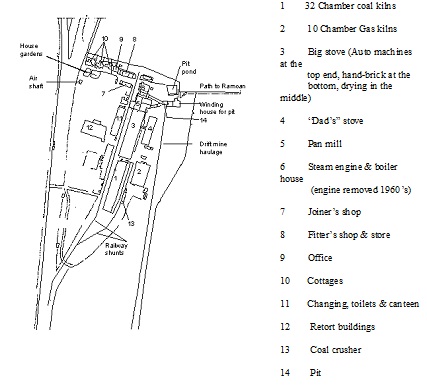

Below – 1858 – Glenboig – how the land looked before the brickworks.
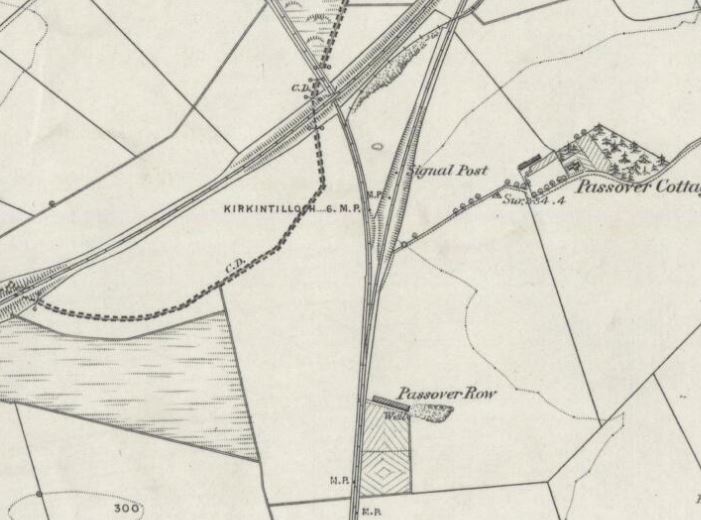
01/06/1881 – Shields Daily News – Mr Hurll, Proprietor of Glenboig Fireclay Works was last week fined £70 under the provisions of the Factory and Workshops Act 1878 for having had on his premises an unfenced shaft by which a young woman lost her life in April last.
Below – 23/12/1882 – First General meeting of the members of the Glenboig Union Fireclay Company – John Hurll presiding.
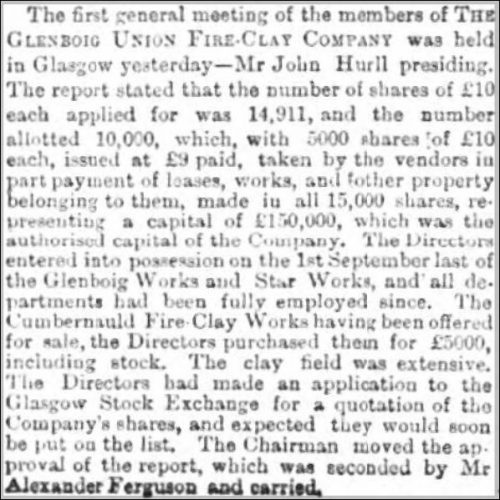
Below – 09/09/1888 – Glasgow Herald – Formation of a co-operative society in Glenboig. Mr Hurll addressed the meeting.

15/04/1889 – Glasgow Evening Post – New brickwork near Coatbridge – Mr Hurl (Hurll) of Glenboig, who was the first to bring into prominence the fine bad of clay at Glenboig has seceded from the Glenboig Fireclay Company and is erecting a large brickwork at Ramone on the estate of Captain Colt of Gartsherrie. Several large tenements of dwelling houses are being run-up in anticipation of the works. It is expected the work will be open in June.
Below – 08/03/1894 – Dundee Courier – Dundee Gas Commission accept tenders. Prices are given.

05/09/1895 – Glasgow Evening Post – Contravention of Friendly Society Act. Prosecution at Airdrie. At Airdrie today, John Hurll, Treasurer of the Gartliston and Garnqueen Friendly Society admitted having paid the funeral costs for a child without receiving a registrar’s certificate of the death in terms of the Friendly Society’s Act. It was stated that these cases were becoming frequent and the registrar general wanted the practice stopped. The minimum penalty of 30s was imposed.
Below – 1896 – Gartliston and Garnqueen Brickworks, Glenboig

1897 – 1898 – Gartliston and Garnqueen Fire Clay Works, Glenboig, Peter & Mark Hurll; office, 144 West Regent St.; depot, head of Glebe Street, St. Rollox; telephone No. 147.
1898 – 1899 – Gartliston and Garnqueen Fire Clay Works, Glenboig, Peter & Mark Hurll; office, 144 West Regent St.; depot, head of Glebe Street, St. Rollox; telephone No. 147.
1899 – 1900 – Gartliston and Garnqueen Fire Clay Works, Glenboig, Peter & Mark Hurll; office, 144 West Regent St.; depot, head of Glebe Street, St. Rollox; telephone No. 147.
1899 – 1900 – Peter and Mark Hurll manufacturers of fire bricks, furnace blocks, gas retorts and fittings, Gartliston and Garnqueen Works, Glenboig. Office 144 West Regent Street. Depot St Rollox. Telephone no 147. Telegram ‘Hurll’ Glasgow.
21/02/1899 – Dundee Advertiser – The personality of Mr John Hurll, Woodneuk, Gartcosh has been returned at £119,495.
16/02/1900 – Ardrossan and Saltcoats Herald – Tenders for new retorts – At a meeting of the Gas Commissioners held on Wednesday evening – Provost Logan presiding -tenders were put forward for the supplying of new retorts. The Glenboig Union Fireclay Co offered to supply 14 retorts at £2 17s 6d each, delivered free on the rail. The only other tender submitted was by P & M Hurll, Glasgow who offered to supply 14 at £ each. Glenboig Coy’s offer was accepted, provided the sizes of the retorts meet with the approval of the manager.
13/10/1900 – Glasgow Herald – A list of ship owners with vessels registered at Port Glasgow – John Henry Hurll, Mark Hurll and Peter Hurll, brick manufacturers, 144 West Regent Street, Glasgow.
1901 – Directory of clay workers – Peter and Mark Hurll, 144 West Regent Street, Glasgow. Fire bricks, fire clayretorts and fittings, sewer pipes. London agents and office – James Reid and Co, 101 Leadenhall Street, E.C. T. addHurll, Glasgow. Tel 147.
13/03/1901 – Kirkintilloch Herald – Miners strike. The fire clay miners employed by Messrs Dunnachie at Glenboig and Gartcosh; Messrs Hurll at Gartliston; and Mr Phaill (Faill?) at Heathfield, Garnkirk have come out. The men some time ago made a demand for an increase of 4d per ton. This the masters refused to grant. The fireclay miners then joined the Lanarkshire Miners County Union, and negotiations were commenced on behalf of the men by Mr Gilmour. On Saturday the demand was modified to an increase of 1 1/2d per ton. Almost simultaneously with this, the masters posted up a notice of a reduction of a penny per ton, with the result that Mr Gilmour has brought the miners out. The number of miners engaged at Glenboig, Gartcosh, Gartliston and Heathfield number about 250. The effect of the strike is likely to throw all the brickworks at these places idle soon as the present surplus stock of fire clay is used up and will consequently cause a very large number of men employed as moulders, burners, etc., to be idle.
06/07/1901 – Kirkintilloch Gazette – The Glenboig Evictions – This forenoon the village of Glenboig was in a perfect fever of excitement. The struggle between the owners of the fireclay mines and their men has been a bitter one. The final proceedings of the chapter were opened today. 3 Sheriff officers from Glasgow arrived before noon and proceeded to Garnqueen Square where they had warrants from the Sheriff to evict the families of Daniel Mackie, who is the secretary of the local miners union, Willam Chesney, J Dunn, J McKee, David Mackie, William Hovie, James Jones and William Hagan. A warrant was also granted to evict Michael Daily but as his wife was confined of a daughter on Monday the officers did not propose doing anything in this case. Arriving at the Square the Sheriff Officers were met by a large crowd. The Square is a hollow one, to which there are only 2 narrow entrances. The crowd arranged themselves here and whenever the officers attempted to force their way in they were driven back with little ceremony. The younger members of the crowd were rather boisterous in their behaviour and the officers consequently came in for a good deal of horseplay. Finding their efforts fruitless they wired away for assistance and a second attempt to evict is to be made this afternoon. This time the officers were assisted by some 50 policemen and they succeeded in forcing open the 8 houses and evicting the occupants. There are still a considerable number of tenants to be evicted.
20/07/1901 – Kirkintilloch Gazette – Glenboig – Contracts have been signed by the Glenboig Union Fireclay Company and P & M Hurll with Mr Graeme Hunter for the supply of workmen for the clay mines at Glenboig, Garnqueen, Gartliston, Gartcosh and Heathfield for a period of 3 years. Mr Hunter has secured or is to secure all the houses of the evicted parties. Those already secured have been furnished and men employed by him are lodged there. A number of new workers are expected from Dundee in a day or two.
03/08/1901 – Kilsyth Chronicle – Glenboig. The evictions. The decrees of ejection granted at Airdrie against the Glenboig Company’s and Messrs Hurll’s workmen in connection with the strike the latter were extracted this week, but the men have nearly all peaceably left the houses, and forcible ejection has not been necessary in any case. Up till Friday, only three men had quit the houses. The pursuers will not probably claim the amount which they are entitled as”violent profits” which means double rent, and security for which was lodged with the Sheriff-Clerk by Mr W. T. Hay, solicitor, Hamilton, to the extent of £200. This, it is understood, is the trades union money.
Further Evictions – The eviction of the last of the fireclay miners on strike took place at Glenboig on Tuesday. Since the warrants were issued and the first ejections carried out, the bulk of the men had been removed from the place; but four families remained, who were, on Tuesday, turned out of their houses at Rock Bank and the Hill by sheriff officers from Glasgow under police protection. In one case a respite was granted till Wednesday, as the miner’s wife was lying ill in the house. The evicted families have had houses provided for them by the Miners Union, either at Shettleston or Garnkirk. What further steps will be taken by the Union remains to seen.
1901 – 1902 – Gartliston and Garnqueen Fire Clay Works, Glenboig, Peter & Mark Hurll; office, 144 West Regent St.; depot, head of Glebe Street, St. Rollox; telephone No. 147.
Jan 1907 – Invoice – Peter and Mark Hurll, Gartliston and Garnqueen Fire Clay Works, Glenboig and Garscube and Knighstwood Brick and Sanitary Pipe Works near Maryhill. Office 144 West Regent Street, Glasgow.
1908 – 1909 – Cowan & Co., building trade, portland cement, fireclay goods, and sanitary earthenware merchants, 16 Charles st. Representing — The Barrett Manufacturing Co.,
London, ” congo ” never-leak roofing; Smith & Sons, Darnley Works, Barrhead, sanitary engineers and bath specialists; Wm. Griffin (successor to J. Wood Aston & Co.), Victoria Forge, Cradley Heath, anchor and cable manufacturers to the admiralty, war office, &c. ; Mayer & Schmidt, Offenbach, O., Maine, emery grinding machines and wheel manufacturers; P. & M. Hurll,
brick makers, Glenboig. Telephone No. 25 y 5.
09/09/1908 – Kirkintilloch Herald – New Company Among the new joint-stock companies registered last month was that of Peter and Mark Hurll, brick manufacturers. Capital £50,000 divided into 25,000 six per cent cumulative preference shares of £1 each and 25,000 ordinary shares of £1 each. First subscribers Peter Hurll, 144 West Regent Street, Glasgow, Mark Hurll, do, Emily Francois Duvoison and John Henry Hurll, Romoan House, Glenboig.
12/09/1908 – The Scotsman – New company. Peter and Mark Hurll Limited, Glasgow (private company), to purchase and take over the business of brick manufacturers carried on at Glasgow, Garnqueen, Glenboig, Knightswood and Garscadden Works near Glasgow. Capital £50,000 in 25,000 pref shares of £1 each and 25,000 ordinary shares of £1 each.
Below – 23/02/1910 – Scene of the explosion at Garnqueen Square, Glenboig owned by Messrs Hurll.
24/02/1910 – The Scotsman – Fatal gelignite explosion at Garnqueen Square, Glenboig owned by Messrs Hurll.
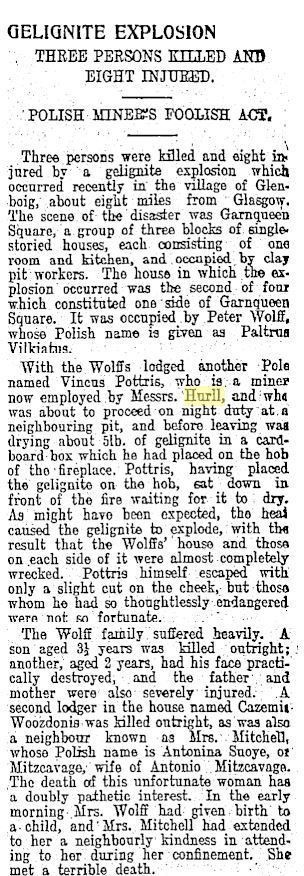

11/03/1910 – The Scotsman – The Glenboig Fatal Explosion – Public enquiry.
Before Sheriff Scott Moncrieff and a jury in the Judiciary Buildings, Glasgow, yesterday, an inquiry was held under the Fatal Accidents Inquiry Acts into the circumstances attending the gelignite explosion in Garnqueen Square, Glenboig, on the 23rd February, by which four persons lost their lives and three houses were destroyed.
The names of the deceased are Kayimiera Uzdonis, otherwise Charles Wolffe, 22 Garnqueen Square, Glenboig; Wincas Wilkaytis, otherwise William Wolffe, 22 Garnqueen Square, Glenboig; Antanina Sudyk or Mickewicza, otherwise Mitchell, 13 Garnqueen Square, Glenboig; and Joseph Wilkaytis, 22 Garnqueen Square, Glenboig. The last-named, a child, died in the Royal Infirmary, the others were killed on the spot.
Mr J. N. Hart, Procurator-Fiscal, conducted the inquiry, and there were also present Major H. Coningham, H.M. Inspector of Explosives, representing the Home Office, and Mr John Hurll representing Messrs J & M Hurll (Limited), firebrick manufacturers, Glenboig, proprietors of Garnqueen Square.
The first witness called was a Lithuanian minor, George Peters, who said that he had assumed that name after coming to this country. He gave evidence as to the removal of the bodies from the wrecked houses. Charles Wolffe and the child William Wolffe were badly cut and smashed and Mrs Mitchell was considerably blackened as if she had been burned.
Mrs Peters, whose evidence was interpreted by her husband, said that she was in the Wolffe house on the night of the explosion. She had gone to inquire about Mrs Wolffe’s newly-born baby. When she was in the house the lodger, Vincus Pottris, came in with a cardboard box, from which he took something. Peter Elliot, another man who was in the house, observed that they were not allowed to take gelignite home with them. Pottris made no reply. She left the house shortly afterwards.
Peter Elliot, or Pyus Alita, another Polish miner, said that after Pottris had taken the cartridge out of the box and examined it he replace it and put the box on top of the stove. Wolffe told him not to put the box there, but he left it, and it was lying there when the witness went out of the house. the explosives were kept at the pithead and generally handed to the men before they went into the mine. Witness had not heard of gelignite being taken home before. e knew it was against the rules. When he told Pottris so the latter made no reply.
Robert Rogerson, 6 Southbank Row, Glenboig, said he was employed by the Glenboig Union Fire Clay Company (Limited) as an explosive magazine keeper for that company’s mines. The practice of giving out explosives to the miners was that the latter sent up their cans on the hutches, and the witness filled them from the warming pan at the pithead and returned them. His authority for having charge of the explosives were contained in a letter from the mine’s manager appointing him to that post. He was the only man who attended to the magazine for the four mines. With each box of gelignite, there was included a handbill on which was printed a warning against placing the cartridges on a hot stove or warm metal, and stating that any attempt to thaw them by any irregular means would inevitably result in an accident. The cartridges had to be softened in specially constructed warming pans, which held nine boxes or 45lb. The box and the handbill were not sent to the men, but the witness had often warned them as to the necessity for care being exercised.
The Procurator-Fiscal – What becomes of the explosive if they take it into the pit and do not use it? Witness – I think they generally leave it in the pit.
Is there any instruction on this point? – No.
Have you any place to keep it in the mine? – I could not say for that.
Have you ever known any of them taking the explosive home with them or away from the pit? – I never knew of it.
How the explosive was procured:-
Witness, continuing, said that all explosives were sent out between 7 A.M. and 1 P.M., after which the magazine was closed. On this occasion, however, they were working on the night shift in consequence of the mine having been flooded. About 2.30 in the afternoon Pottris approached the witness and asked him for a box of gelignite, as he was going on the night shift, which lasted from about nine o’clock at night till six in the morning to supply him until he had examined the condition of the gelignite in the magazine. Later he told Pottris to call his house at 6 P.M., and he would give him the explosive. The witness was at the warming pan till 5.30, and three minutes after he reached home Pottris arrived. Witness handed him the box of gelignite and a coil of the fuse. Witness had not taken gelignite home before and did not know at that time it was against the rules. A box of gelignite weighed 5 lb. and contained 46 or 48 cartridges. Pottris had not his can with him, and, witness forgot to ask him for it. He did not know Pottris was going to take the box home, as he said he was going on the night shift. It was about six o’clock then, and the night shift began about nine. The gelignite had been in the warming pan during the afternoon and was fully prepared.
In reply to Mr Hurll, the witness said that when the gelignite passed out of his hands it became the property of the miners. They bought it, and he kept books for his accounts. If gelignite was properly thawed it would take a day or two for it to get hard again.
John Douglas, works manager of the Glenboig Union Fireclay Company, said there was a certificate for explosives in the name of the secretary of the company, and they had a store licence and a police certificate to authorise them to keep explosives.
An agent stated that he had advised Pottris not to give evidence at that inquiry.
The jury returned a formal verdict in accordance with the evidence.
18/08/1911 – The Kirkintilloch Gazette – Chryston – Death of County Councillor Hurll – The death occurred at Woodneuk, Gartcosh on Monday of Mr Peter Hurll of the well-known firm of fireclay manufacturers. Peter and Mark Hurll Ltd. Mr Hurll was in his 70th year and up until a month or two ago was actively involved in the business. On the advice of his medical advisor, he relinquished his duties and contemplated going off for a change and extended rest. On the retiral of Mr W.C.B Christie of Bedlay from Lanarkshire County Council, Mr Hurll acceded to a request from all sections of the community to come forward as the representative for the Chryston Ward in the County Council and was returned unopposed in November 1909. Mr Hurll led a strenuous life and while acting as Managing Director of P & M Hurll, attended very assiduously to the duties which devolved on him in his public capacity … The funeral took place yesterday to Bedlay Cemetery.
06/03/1912 – Kirkintilloch – … The strike is having a serious effect on the other industries in the district, work having been suspended at the works of Heathfield and Cardowan Fireclay Co Ltd, Heathfield; The Glenboig Union Fireclay Coy Ltd at Gartcosh, Glenboig and Cumbernauld; Messrs P & M Hurll’s Ltd Brickworks, Glenboig …
24/08/1912 – Airdrie and Coatbridge Advertiser – Glenboig brickworks and pits are thrown idle. The torrential rains experienced during the last few days have done much damage in the Glenboig district, and among the sufferers in this respect are Messrs P and M Hurll, firebrick manufacturers, Glenboig whose pits and works situated at Garnqueen are completely stopped owing to subsidence and the flooding of their pit workings. The occurrence took place on Tuesday morning and is similar to an accident at the same place on January 23 last, but this time the damage is more extensive, and it will require days of strenuous labour to place everything in working order. The abyss caused by the subsidence is about 150 feet in diameter and 50 feet deep. Messrs Hurll have circularised their customers of the stoppage, and that neither labour nor experts are being spared to have the works set agoing. The water completely flooded all the low-lying workings and was four feet up the shaft but special pumps are being placed which should be able to throw large volumes of water to the surface. It has also been arranged to double shift the Gartliston works and pits so that their customers will be treated to the minimum of inconvenience.
11/12/1912 – Kirkintilloch Herald – Fireclay miners and drawers wanted: miners 6 shillings and sixpence to 8 shillings and sixpence per day, 6 days per week. Apply to P & M Hurll Ltd, Gartliston and Garnqueen Fireclay Works, Glenboig.
1914 – 1918 – The 1985 publication ‘A survey of Scottish brickmarks’ suggests the Eglinton Silica Brick Co Ltd operated the works during this time.
21/03/1916 – Daily Record – Men wanted immediately for temporary employment during this week discharging magnesite from wagons on to the ground; 6d per ton will be paid each man as soon as wagons are emptied … The Eglinton Silica Brick Co Ltd., Garnqueen Brickworks, Glenboig.
10/01/1917 – Kirkintilloch Herald – The minutes of the Cadder Water Committee stated that the water supply for Garnqueen Brickworks was being taken from the Airdrie and Coatbridge Water Trust. The committee’s finding was that in ordinary circumstances they would object to another authority supplying water within the Cadder Water district but in the special circumstances of the case they would be disposed to agree to it, in order to conserve the supply of domestic purposes inn the Glenboig area, but would insist that the works be subject to the Cadder water assessments.
18/08/1917 – Coatbridge Leader – Brick workers wages increased. Professor Irvine has sent to Baillie Climie, Workers Union, the following award dealing with the men employed at the Dundyvan and Garnqueen Works of the Eglinton Silica Brick Company Ltd. ” That as from 19th April 1917, the wages of male workers of 18 years of age and over in the employ of the firm shall be increased by 4s per week, and that the wages of boys and youths under years of age in the employ of the firm shall be increased by 2s per week. The amounts hereby awarded are to be regarded as war advances, intended to assist in meeting the increased cost of living and are to be recognised as due to and dependent on the existence of the abnormal conditions now prevailing in consequence of the war; that the advance of 2s per week offered by the firm to the workmen on or after 19th April, and accepted by certain of the workmen, shall merge in the advance hereby awarded; and that the claim for double-time payment for Sunday work has not been established.”
29/10/1917 – Hamilton Advertiser – Brickwork. Skilled men wanted. Garnqueen Brickworks, Glenboig. All class A government work.
12/12/1917 – Daily Record – Bricklayers wanted at Garnqueen brickworks, Glenboig. Class A work – Eglinton Silica Brick Company.
Six brick workers wanted at Garnqueen brickworks, Glenboig. Class A work – Eglinton Silica Brick Company.
18/04/1919 – The Scotsman – Important sale of bricmaking plant and machinery at Garnqueen Brickworks, Glenboig on Tuesday 6th May 1919 at 12 o’clock. Shirlaw and Allan and Co, auctioneers, Hamilton have received instructions from Messrs Eglington Silica Brick Co Ltd, 45 Renfield Street, Glasgow to sell by auction as above.
Below – 29/04/1919 – Sheffield Daily Telegraph – On the instructions of the Eglinton Silica Brick Company the Garnqueen Brickworks are for sale.


10/10/1919 – Milngavie and Bearsden Herald – Cadder Parish Council – Rates – A statement was submitted showing a decrease in the valuation of the Parish. This was explained was mainly due to a fall in the assessable valuation of minerals … The Garnqueen Fire Clay Works which was on the rolls last year at £2080 was not on the roll this year.
25/06/1928 – Aberdeen Press and Journal – The Scottish fire brick trade has sustained a loss after the passing of Mark Hurll, managing director of Peter and Mark Hurll Ltd, Glenboig. Mr Hurl was on a fishing holiday at Hillswick, Shetland when the end came suddenly. Mr Hurll founded the well-known firm of Peter and Mark Hurll Ltd, Glenboig. He was also interested in the coal industry and retired only recently from the Vernon Coal Company.
29/06/1928 – Milngavie and Bearsden Herald – Temple. Sudden death of Mr Mark Hurll. Mr Mark Hurll, chairman of the firm of Messrs Peter and Mark Hurll Limited, brick manufacturers, Glasgow died suddenly on holiday at Hillswick, Shetland on Thursday. He was a keen angler and had made several trips to Shetland in pursuit of his favourite sport. Mr Hurll was a Lanarkshire man, about 78 years of age. and spent his early days in the Garnkirk district. In the early seventies, he became associated with the firm Messrs Hurll, Young and Co who had a brick-making establishment in Glenboig. He was connected also with the coal industry having been interested for many years in collieries in the Blantyre district. In the latter years of his life, he was associated with the Mount Vernon Colliery Company. Mr Hurll is succeeded in the brick-making business by two of his sons, Mr Mark Hurll and Mr Thomas R. C. Hurll.
Below – 29/06/1928 – Kirkintilloch Gazette – Death of a well-known brickmaker. On Thursday last week Mr Mark Hurll, chairman of Messrs Peter and Mark Hurll Ltd, the well-known brickmakers, died suddenly at Hillsurch, Shetland where he was on a fishing holiday. The deceased who was 78 years of age was a Lanarkshire man. His youth was spent in the Garnkirk district but after training as an engineer he spent some time in Germany. Returning to this country in the early seventies he became associated with the firm Messrs Hurll, Young and Co who had a brick-making establishment in Glenboig. He remained in the business at Glenboig until about 1888 when in company with his brother Mr Peter Hurll he founded the present Glasgow firm which later was registered as a limited company. Mr Hurll was also interested in the coal industry. In his business which has works at Glenboig and Drumchapel, he is succeeded by his sons Messrs Mark and Thomas R. C. Hurll.
11/01/1929 – Milngavie and Bearsden Herald – To mark the occasion of his appointment as managing director of the firm P & M Hurll Ltd, fire brick manufacturers, Glenboig, the workers of Gartliston and Garnqueen works met Mr Mark Hurll and presented him with a beautiful gramophone and records.
1930s – In the 1930s P & M Hurll supplied the bricks with which Mactaggart and Mickel built the Knightswood Estates, Glasgow. 52/6 a thousand delivered on-site -Source Eric Flack
Below – 22/11/1933 – Kirkintilloch Herald – Peter and Mark Hurll Ltd at court regarding injuries suffered by Robert Heron – Workmen’s Compensation Act.
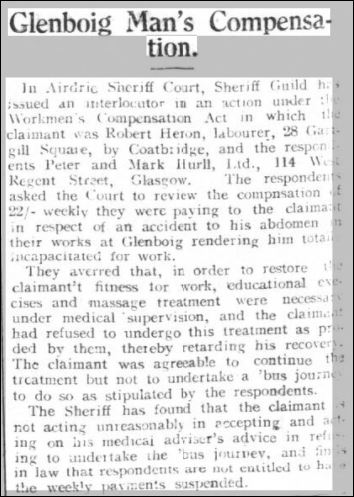
Below – 1935 – 1936 – Gartliston and Garnqueen Brickworks, Glenboig.
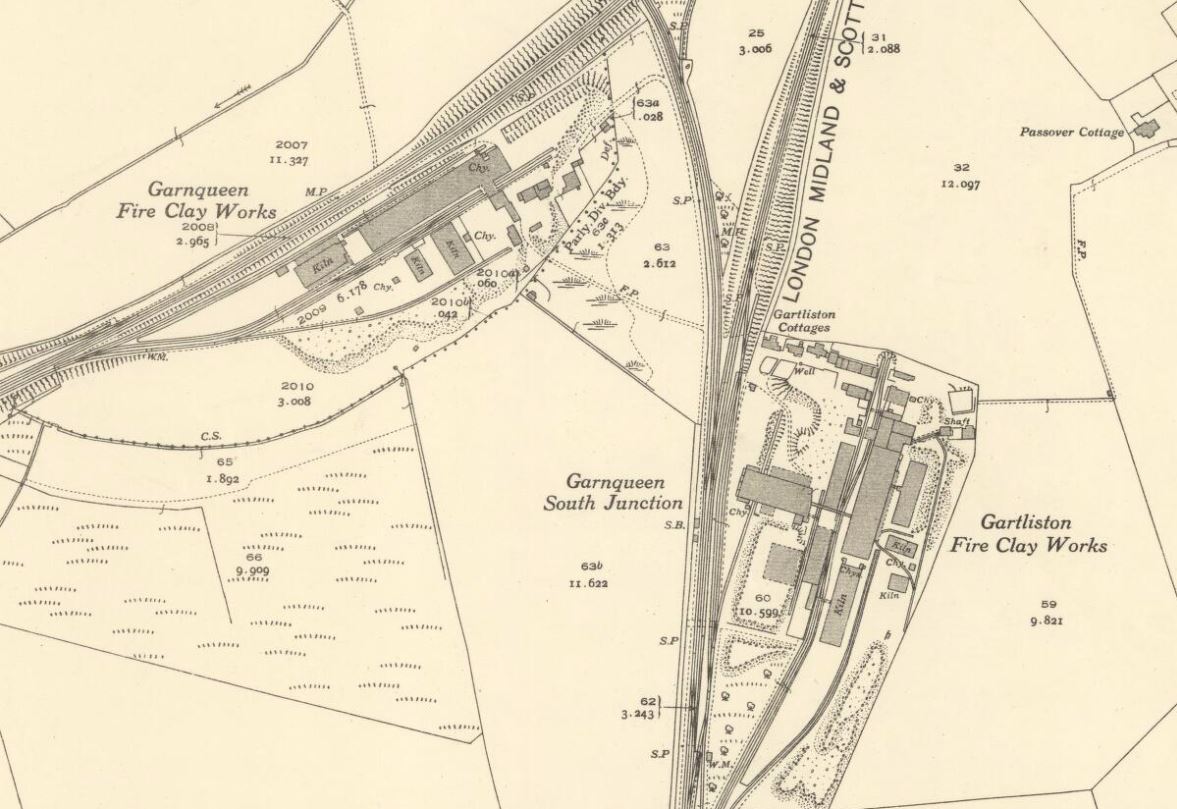
Below – 1944 – 1967 – Garnqueen Fireclay Works.

17/03/1947 – Dundee Evening Telegraph – Brick trade needs more machinery. The first report of the Technical Committee of the National Brick Advisory Council, which is issued today as a White Paper, estimates that it should be possible to produce the pre-war output of bricks with between 6000 and 15,000 operatives fewer than the pre-war labour force of 53,000 by making more use of machinery. The Ministry of Works are urged to arrange priority for orders for excavating, conveying and brick-making plant, assist manufacturers to obtain labour and raw materials, and consider whether manufacturing capacity and facilities are adequate. Although mechanical excavation was introduced in 1907, 70 per cent, of the brickworks still adhere to manual methods of winning clay. The report gives as an illustration that while a man engaged in full-time hand wheeling to a kiln may walk 10 miles a day and move 40 tons of bricks, a mechanical truck should handle 130,000 bricks a week and replace three unskilled workers with one skilled worker. Both sides of the industry were represented on the committee, whose chairman was Mr Lockhart W. Hutson, F.R.1.8.A., Hamilton. Mr T. R. C. Hurll, of P. B. M. Hurll, Coatbridge, was the other Scottish member of the committee. (Note – SBH – I assume P B M Hurll should read P & M Hurll).
13/03/1954 – Airdrie and Coatbridge Advertiser – £20,000 action is abandoned. Former chairman withdraws allegations. The £20,000 civil action raised in Airdrie Sheriff Court last week by Mr Mark Hurll, former chairman of a Glenboig brickworks company came to a sudden end of Friday. After negotiations outside the court, it was announced that Mr Hurll was abandoning the action. For a week, evidence had been led before Sheriff A.J Stevenson regarding Mr Hurll’s claim for £20,000 against three of his former fellow directors of the firm, Peter and Mark Hurll, brick and firebrick manufacturers, Garnqueen Works, Glenboig. The defenders whom he was suing were his brother Thomas, R. C. Hurll, 8 Boclair Crescent, Hillfoot, Bearsden; his cousin Alexander H. Duvoisin, Ramoan House, Glenboig; and R. H. Thomson, 39 Gordon Road, Netherlee, Glasgow. Since 1924 Mark Hurll had been chairman of the board of directors of the firm which was a family concern. With two exceptions all the shareholders were related to each other. In August 1951 he was voted off the board of directors at an extraordinary general meeting. Before this meeting took place a letter had been circulated among certain of the shareholders by the three directors, T. R. C. Hurll, A. H. Duvoisin and R. H. Thomson and Mark Hurll alleged that it contained half-truths and untrue and misleading statements, falsely and fraudulently representing him to have been guilty of conduct prejudicial to the company and to the interests of the shareholders and to be a person unfitted to continue in office as a director of the company. The directors had stated in their circular letter that they had not approved Mark Hurll’s son for promotion in the company and that Mark Hurll had treated this on a personal basis and displayed a great amount of personal animosity towards them. He gave up all friendly co-operation, they stated, and failed to resume certain important functions. He later proposed that the assets of the company be sold. They maintained that these statements were true and had been made in good faith and without malice and in the honest belief that it was their duty in the interests of the company. Mr Lionel H. Daiches, advocate, conducted the case for Mark Hurll and on Friday asked Sheriff Stevenson to grant an adjournment. For almost an hour there were negotiations between Mr Daiches and Mr J. O. M. Hunter, Q. C. for the defenders. When the court resumed, Mr Daiches said that as a result of the efforts of counsel and himself, his client now abandoned the action. This step was being taken, as far as he was concerned, with a view to preventing any more increase of family strife because unfortunately, it was a family action. Mr Daiches said that this course would also carry an award of expenses against his client. In order to clear the air completely, he added, my client withdraws any allegations made of conspiracy or fraud on the part of the defenders. Mr Hunter said that this was entirely satisfactory and stressed that all allegations of fraud and conspiracy were unreservedly withdrawn.
1962 – The 1985 publication ‘A survey of Scottish brickmarks’ suggests the Hurlls stopped operating the works around this time.
c. 1970 – The 1985 publication ‘A survey of Scottish brickmarks’ suggests the works were demolished in the early 1970s.
Below – Peter and Mark Hurll Ltd, Glenboig Coatbridge, Scotland – A blank delivery note.

.
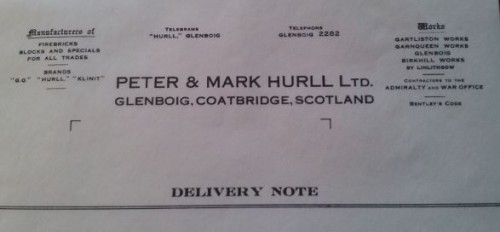 .
.
Note the reference to Bentleys Code –
- Bentleys Second Phrase The “Bentleys Code Phrases” [ http://www.archive.org/details/bentleyscomplete00bentuoft ] first published in 1906 continued to be commonly used till the end of the 1960s. That and other codes were widely used by commercial establishments. “Coding” was popular then at grass root levels. If the 5 letter codes were well understood, popular and used widely, there are no reasons why the present coding done with computer languages based on 8-bit octets cant be used with the same ease by the general public. Coding languages need to start circulating widely among the public the way Bentleys Code ruled from 1906 to the 1960s.
- Bentleys Code: A sample Genesis: In the late 19th and earlier 20th Centuries, there were Code Books created because telegram messages were charged by the word. As many as ten characters in a grouping were considered a word by the telegraph companies. Commercial Code Books, such as the Acme Code Words, or the Bentleys Complete Phrase Code were available to companies, enabling them to send complex messages in only a few “words.” Sample: For instance, if someone used Bentley’s phrasebook, he or she might choose the following letter groupings: DIZUH (contracts for) DAELF (computing) FEAVO (equipment) RUGUB (has/have been signed) KUKIB (New York) CUGYA (commence) OKGAP (production) ICSCO (immediately). Thus, the message, DIZUHDAELF FEAVORIGUB KUKIBCUGYA OKGAPICSCO, four “words,” would translate to, “Contracts for computing equipment have been signed [in] New York. Commence production immediately.” This would be in place of 12 normal words (13 if the implied “in” is included); a savings of at least 75 per cent. Of course, for someone without the Code Book, the message would be unreadable, but the message was sent primarily for the economy, not security.
Below – Illustrated catalogue (date unknown) – ‘HURLL’ Firebricks, covers etc – Peter and Mark Hurll Limited, Glenboig, Coatbridge, Scotland.

PETER & MARK HURLL
LIMITED,
GLENBOIG,
COATBRIDGE, SCOTLAND
TELEGRAMS AND CABLES . . . “HURLL, GLENBOIG”
TELEPHONE . . . . . . . . . GLENBOIG 2282
Code Used: BENTLEY’S
Shipping Ports
CLYDE AND FORTH
BRANDS REGISTERED
“HURLL” “KLINIT”
ON ADMIRALTY AND WAR OFFICE LISTS
Works
GARTLISTON FIREBRICK WORKS
AND
GARNQUEEN FIREBRICK WORKS
GLENBOIG
LANARKSHIRE
————
BIRKHILL FIRECLAY WORKS
BY LINLITHGOW
WEST LOTHIAN
Peter and Mark Hurll Limited – During the last hundred years, the name Hurll has been prominent in the history of the development of the Scottish firebrick industry, which in that time has built up at home and abroad a well-deserved reputation for the excellence of its products.
This long association with the industry started about 1835 when Mr John Hurll was first associated with the Garnkirk Fireclay Company, whose “Garnkirk” brand of firebrick was probably the first well-known Scottish firebrick.
In 1852 Mr John Hurll joined the partnership with Mr John Young, also of the Garnkirk Company, to form the firm of Hurll, Young & Company. The first works built and operated by this firm were Cardowan Fireclay Works, but the rapid expansion of their business led to the acquisition in 1860 of Heathfield Works from Messrs Miller & Ferguson, and the purchase in 1865 of Glenboig Works from Messrs Thomson, McLean & Company.
Fireclay had been first worked at Glenboig in 1836, but development had been so slight that in 1860 the population of Glenboig’s village was only about 120. The Glenboig Works were carried on under the control of Hurll, Young & Company until 1874 when the partnership was dissolved, Mr John Hurll purchasing the Glenboig Works and Mr Young purchasing Heathfield and Cardowan Works.
During the period of control by the original firm, and later while controlled by Mr John Hurll as an individual, the works extended rapidly, and by 1882-when Mr Hurll sold the Glenboig Works and retired-had become the best-known Fireclay works in Britain with a worldwide reputation for the excellence of their products.
In 1888 two sons of Mr John Hurll, Mr Peter Hurll and Mr Mark Hurll, both of whom had a complete knowledge of the organisation and management of the older works, entered into a partnership. Gartliston Pit was sunk half a mile to the south of Glenboig Station to the Glenboig Fireclay in the lower Millstone Grit, and Gartliston Works were built. A sound connection was very quickly built upon the merits of the products of the works, as the raw fireclay proved to be of excellent quality and the methods of manufacture and business outlook of the new partnership thoroughly up to date.
The steadily increasing demand for “HURLL” firebricks, as the products of Gartliston Works are known, was met by the sinking of a second pit at Glenboig in 1895, and the building of Garnqueen Works. Further developments followed in 1908 when a seam of Fireclay near Manuel, Linlithgowshire, which had been worked to a very small extent in the middle of the last century, was investigated. This clay proved to be highly aluminous and of very constant composition peculiar to this district. A mine was driven and firebricks from this clay are now marketed under the brand “KLINIT,” These bricks have set a new standard in high melting point natural aluminous refractories without admixture of other material.
In each district, only the true first-quality seam is worked, and the raw material is selected to maintain the quality of the product at a uniformly high standard. Modern plant is installed and maintained in the works to produce only sound, well-shaped, and hard-burned refractories.
The “HURLL” bricks, blocks, and retorts manufactured at our Gartliston and our Garnqueen Works, Glenboig, are justly favoured in Britain and its Colonies, on the Continent of Europe, and in many countries abroad for their long life when subjected to high or rapidly varying temperatures. It is very noteworthy that these bricks do not “spall” or break in the furnace, hence there is no weakening of the brickwork or damage to the contents of the furnace from falling pieces. The material manufactured and burned by us has a minimum of expansion or contraction.
Suitable grades produced are used by leading firms for steel and iron furnaces and ladles, stoves, cupolas, pottery kilns, chemical and glass furnaces, locomotives, fire-tube and water-tube boilers.
The “KLINIT” bricks are used where conditions are exceptionally severe, and there is a rapidly increasing demand for bricks made from this clay. Where pulverised coal or oil fuel is used or where it is of first importance that a furnace should be kept under heat continuously for long periods, these bricks are unrivalled. The remarkably high thermal stability records, measured by Seger Cones, are noteworthy, as they reach the unusually high figure of Cone 34-35
Below – Railway wagon label for ground fireclay from P & M Hurll Ltd, Manuel.

Below – Tombstone Bedlay Cemetery, Chryston, Glasgow – In affectionate remembrance of Isabella McGlashan wife of John Hurll of Woodneuk who died on 09/08/1874. Her children arise up and call her blessed, her husband also and be praised together. John Hurll of Woodneuk, born 12/11/1812 died 27/12/1898, Amy wife of Alexander Hurll, Bearsden died 13/02/1925. Mary Hurll died 18/12/1925. The above Alexander Hurll died 25/05/1929.

***********
Alexander Hurll – 1855 – 27/05/1929.
Peter Hurll – 1841 – 14/08/1911.
John Hurll – 1843 – ? (Solicitor).
Mark Hurll – 1849 – 21/06/1928.
**********
Below – Undated. Original source unknown – Peter and Mark Hurll advert – Gartliston, Garnqueen, Garscube and Knightswood.










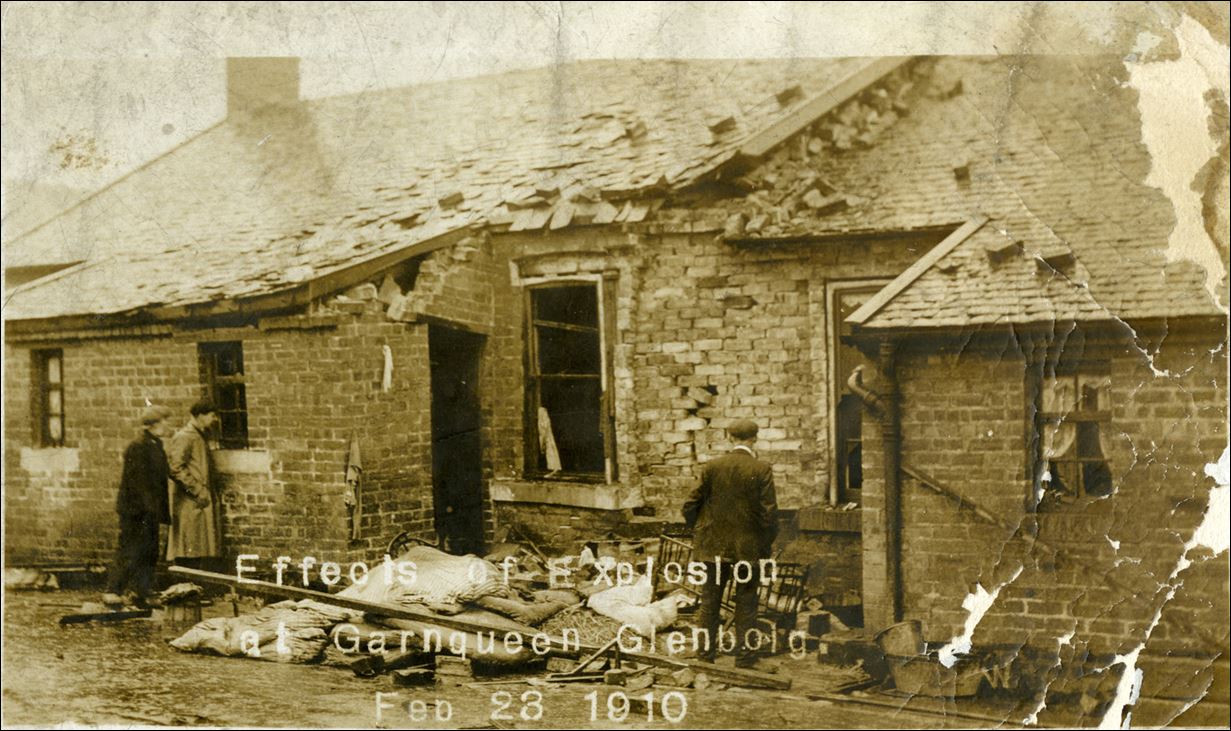








 .
. 



